MITS5001 Report: Implementation of Queensland Health Payroll System
VerifiedAdded on 2022/12/19
|8
|2185
|73
Report
AI Summary
This report provides a comprehensive analysis of the Queensland Health payroll system implementation, focusing on the challenges encountered since its introduction in 2010. The system, comprising Working Brain and SAP, faced significant issues including technical infrastructure failures, payroll backlogs, and complexities arising from award conditions and customizations. The report delves into the reasons behind these failures, such as insufficient time for implementation, poor communication, inadequate testing, and project management problems. It also explores proposed strategies to improve the system's performance, including upgrading customizations, ensuring payroll accuracy, and implementing new policies to address historical payroll submissions. The report concludes by emphasizing the need for improved data and communication policies within Queensland Health to prevent future failures and enhance the overall efficiency of the payroll system.
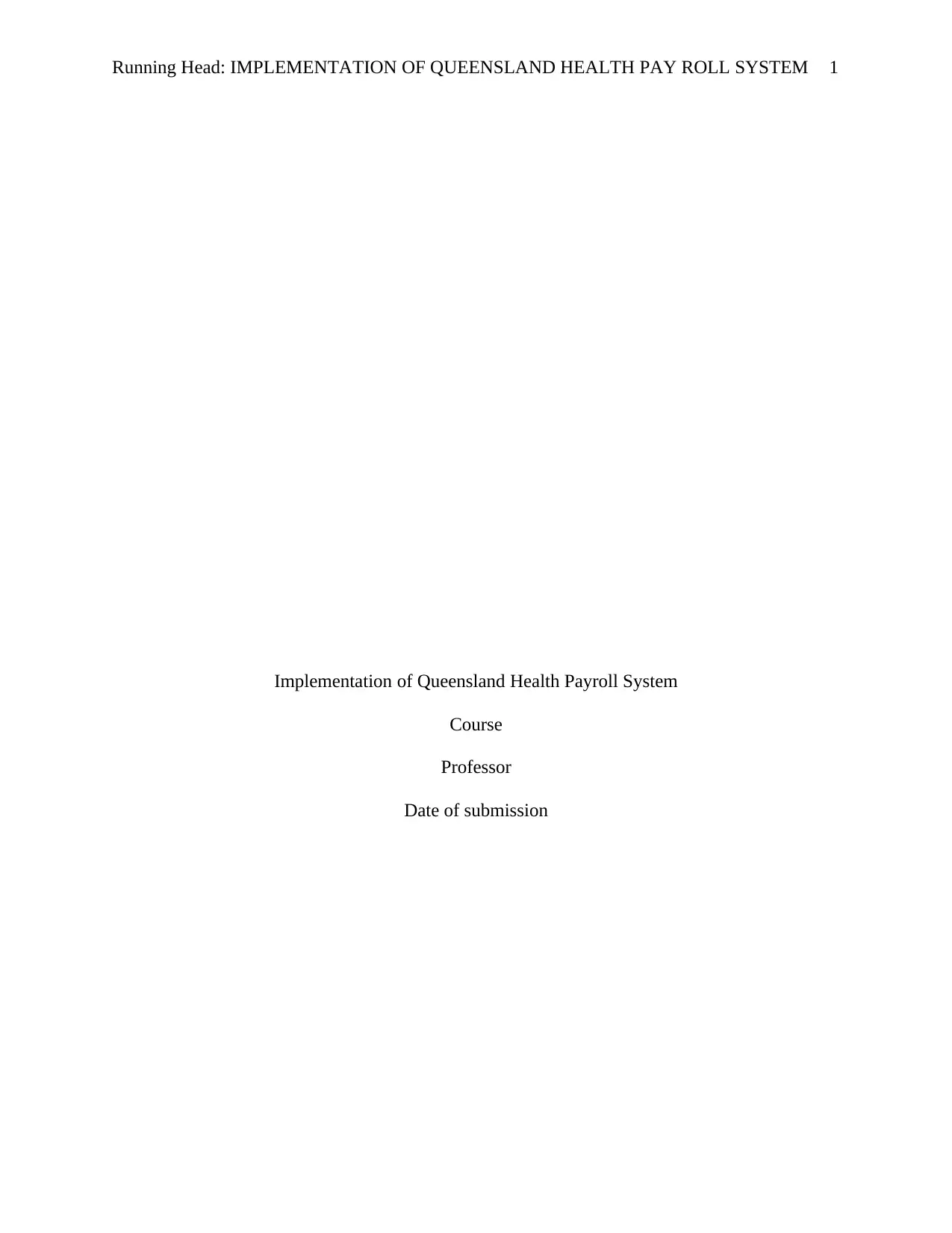
Running Head: IMPLEMENTATION OF QUEENSLAND HEALTH PAY ROLL SYSTEM 1
Implementation of Queensland Health Payroll System
Course
Professor
Date of submission
Implementation of Queensland Health Payroll System
Course
Professor
Date of submission
Paraphrase This Document
Need a fresh take? Get an instant paraphrase of this document with our AI Paraphraser
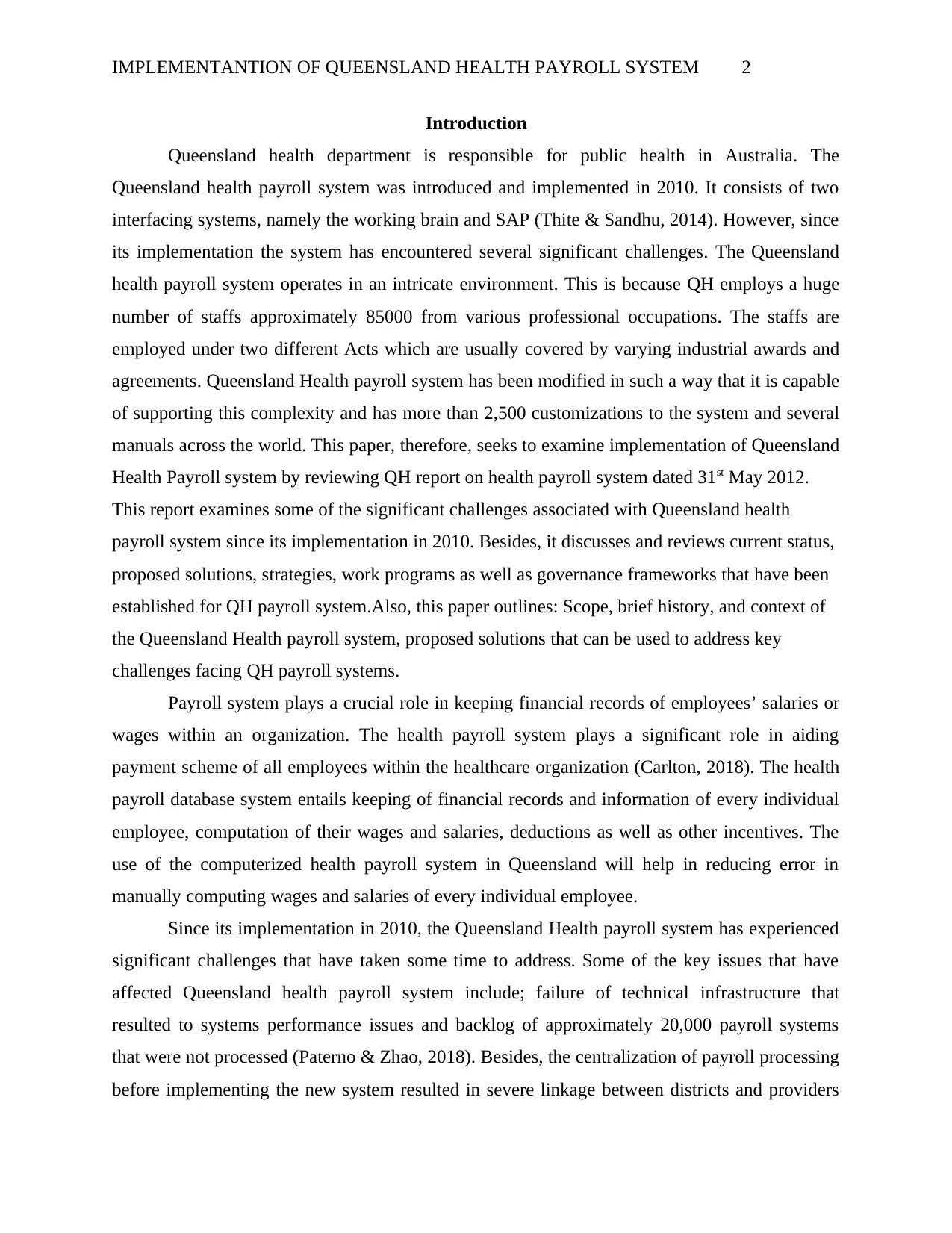
IMPLEMENTANTION OF QUEENSLAND HEALTH PAYROLL SYSTEM 2
Introduction
Queensland health department is responsible for public health in Australia. The
Queensland health payroll system was introduced and implemented in 2010. It consists of two
interfacing systems, namely the working brain and SAP (Thite & Sandhu, 2014). However, since
its implementation the system has encountered several significant challenges. The Queensland
health payroll system operates in an intricate environment. This is because QH employs a huge
number of staffs approximately 85000 from various professional occupations. The staffs are
employed under two different Acts which are usually covered by varying industrial awards and
agreements. Queensland Health payroll system has been modified in such a way that it is capable
of supporting this complexity and has more than 2,500 customizations to the system and several
manuals across the world. This paper, therefore, seeks to examine implementation of Queensland
Health Payroll system by reviewing QH report on health payroll system dated 31st May 2012.
This report examines some of the significant challenges associated with Queensland health
payroll system since its implementation in 2010. Besides, it discusses and reviews current status,
proposed solutions, strategies, work programs as well as governance frameworks that have been
established for QH payroll system.Also, this paper outlines: Scope, brief history, and context of
the Queensland Health payroll system, proposed solutions that can be used to address key
challenges facing QH payroll systems.
Payroll system plays a crucial role in keeping financial records of employees’ salaries or
wages within an organization. The health payroll system plays a significant role in aiding
payment scheme of all employees within the healthcare organization (Carlton, 2018). The health
payroll database system entails keeping of financial records and information of every individual
employee, computation of their wages and salaries, deductions as well as other incentives. The
use of the computerized health payroll system in Queensland will help in reducing error in
manually computing wages and salaries of every individual employee.
Since its implementation in 2010, the Queensland Health payroll system has experienced
significant challenges that have taken some time to address. Some of the key issues that have
affected Queensland health payroll system include; failure of technical infrastructure that
resulted to systems performance issues and backlog of approximately 20,000 payroll systems
that were not processed (Paterno & Zhao, 2018). Besides, the centralization of payroll processing
before implementing the new system resulted in severe linkage between districts and providers
Introduction
Queensland health department is responsible for public health in Australia. The
Queensland health payroll system was introduced and implemented in 2010. It consists of two
interfacing systems, namely the working brain and SAP (Thite & Sandhu, 2014). However, since
its implementation the system has encountered several significant challenges. The Queensland
health payroll system operates in an intricate environment. This is because QH employs a huge
number of staffs approximately 85000 from various professional occupations. The staffs are
employed under two different Acts which are usually covered by varying industrial awards and
agreements. Queensland Health payroll system has been modified in such a way that it is capable
of supporting this complexity and has more than 2,500 customizations to the system and several
manuals across the world. This paper, therefore, seeks to examine implementation of Queensland
Health Payroll system by reviewing QH report on health payroll system dated 31st May 2012.
This report examines some of the significant challenges associated with Queensland health
payroll system since its implementation in 2010. Besides, it discusses and reviews current status,
proposed solutions, strategies, work programs as well as governance frameworks that have been
established for QH payroll system.Also, this paper outlines: Scope, brief history, and context of
the Queensland Health payroll system, proposed solutions that can be used to address key
challenges facing QH payroll systems.
Payroll system plays a crucial role in keeping financial records of employees’ salaries or
wages within an organization. The health payroll system plays a significant role in aiding
payment scheme of all employees within the healthcare organization (Carlton, 2018). The health
payroll database system entails keeping of financial records and information of every individual
employee, computation of their wages and salaries, deductions as well as other incentives. The
use of the computerized health payroll system in Queensland will help in reducing error in
manually computing wages and salaries of every individual employee.
Since its implementation in 2010, the Queensland Health payroll system has experienced
significant challenges that have taken some time to address. Some of the key issues that have
affected Queensland health payroll system include; failure of technical infrastructure that
resulted to systems performance issues and backlog of approximately 20,000 payroll systems
that were not processed (Paterno & Zhao, 2018). Besides, the centralization of payroll processing
before implementing the new system resulted in severe linkage between districts and providers
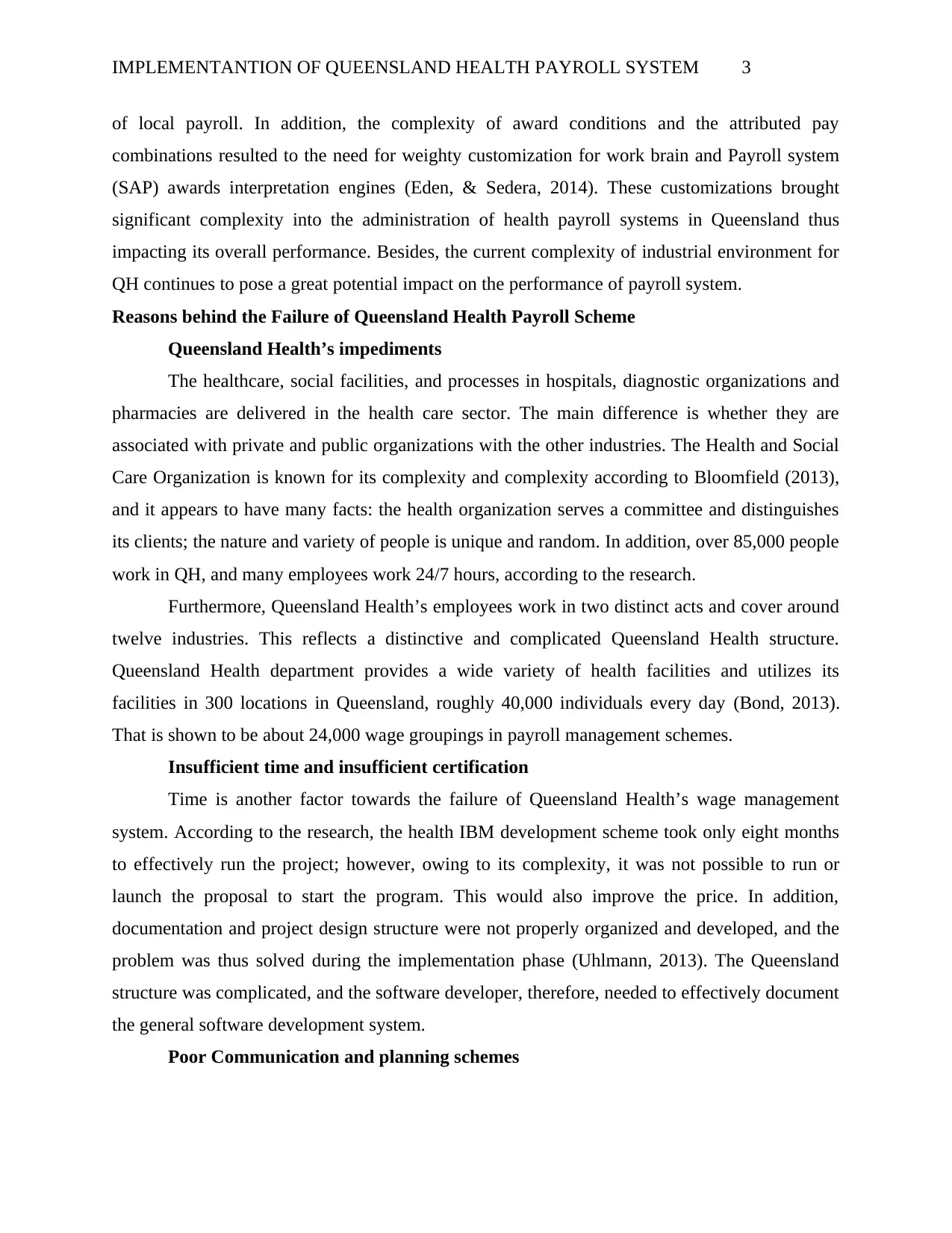
IMPLEMENTANTION OF QUEENSLAND HEALTH PAYROLL SYSTEM 3
of local payroll. In addition, the complexity of award conditions and the attributed pay
combinations resulted to the need for weighty customization for work brain and Payroll system
(SAP) awards interpretation engines (Eden, & Sedera, 2014). These customizations brought
significant complexity into the administration of health payroll systems in Queensland thus
impacting its overall performance. Besides, the current complexity of industrial environment for
QH continues to pose a great potential impact on the performance of payroll system.
Reasons behind the Failure of Queensland Health Payroll Scheme
Queensland Health’s impediments
The healthcare, social facilities, and processes in hospitals, diagnostic organizations and
pharmacies are delivered in the health care sector. The main difference is whether they are
associated with private and public organizations with the other industries. The Health and Social
Care Organization is known for its complexity and complexity according to Bloomfield (2013),
and it appears to have many facts: the health organization serves a committee and distinguishes
its clients; the nature and variety of people is unique and random. In addition, over 85,000 people
work in QH, and many employees work 24/7 hours, according to the research.
Furthermore, Queensland Health’s employees work in two distinct acts and cover around
twelve industries. This reflects a distinctive and complicated Queensland Health structure.
Queensland Health department provides a wide variety of health facilities and utilizes its
facilities in 300 locations in Queensland, roughly 40,000 individuals every day (Bond, 2013).
That is shown to be about 24,000 wage groupings in payroll management schemes.
Insufficient time and insufficient certification
Time is another factor towards the failure of Queensland Health’s wage management
system. According to the research, the health IBM development scheme took only eight months
to effectively run the project; however, owing to its complexity, it was not possible to run or
launch the proposal to start the program. This would also improve the price. In addition,
documentation and project design structure were not properly organized and developed, and the
problem was thus solved during the implementation phase (Uhlmann, 2013). The Queensland
structure was complicated, and the software developer, therefore, needed to effectively document
the general software development system.
Poor Communication and planning schemes
of local payroll. In addition, the complexity of award conditions and the attributed pay
combinations resulted to the need for weighty customization for work brain and Payroll system
(SAP) awards interpretation engines (Eden, & Sedera, 2014). These customizations brought
significant complexity into the administration of health payroll systems in Queensland thus
impacting its overall performance. Besides, the current complexity of industrial environment for
QH continues to pose a great potential impact on the performance of payroll system.
Reasons behind the Failure of Queensland Health Payroll Scheme
Queensland Health’s impediments
The healthcare, social facilities, and processes in hospitals, diagnostic organizations and
pharmacies are delivered in the health care sector. The main difference is whether they are
associated with private and public organizations with the other industries. The Health and Social
Care Organization is known for its complexity and complexity according to Bloomfield (2013),
and it appears to have many facts: the health organization serves a committee and distinguishes
its clients; the nature and variety of people is unique and random. In addition, over 85,000 people
work in QH, and many employees work 24/7 hours, according to the research.
Furthermore, Queensland Health’s employees work in two distinct acts and cover around
twelve industries. This reflects a distinctive and complicated Queensland Health structure.
Queensland Health department provides a wide variety of health facilities and utilizes its
facilities in 300 locations in Queensland, roughly 40,000 individuals every day (Bond, 2013).
That is shown to be about 24,000 wage groupings in payroll management schemes.
Insufficient time and insufficient certification
Time is another factor towards the failure of Queensland Health’s wage management
system. According to the research, the health IBM development scheme took only eight months
to effectively run the project; however, owing to its complexity, it was not possible to run or
launch the proposal to start the program. This would also improve the price. In addition,
documentation and project design structure were not properly organized and developed, and the
problem was thus solved during the implementation phase (Uhlmann, 2013). The Queensland
structure was complicated, and the software developer, therefore, needed to effectively document
the general software development system.
Poor Communication and planning schemes
⊘ This is a preview!⊘
Do you want full access?
Subscribe today to unlock all pages.

Trusted by 1+ million students worldwide
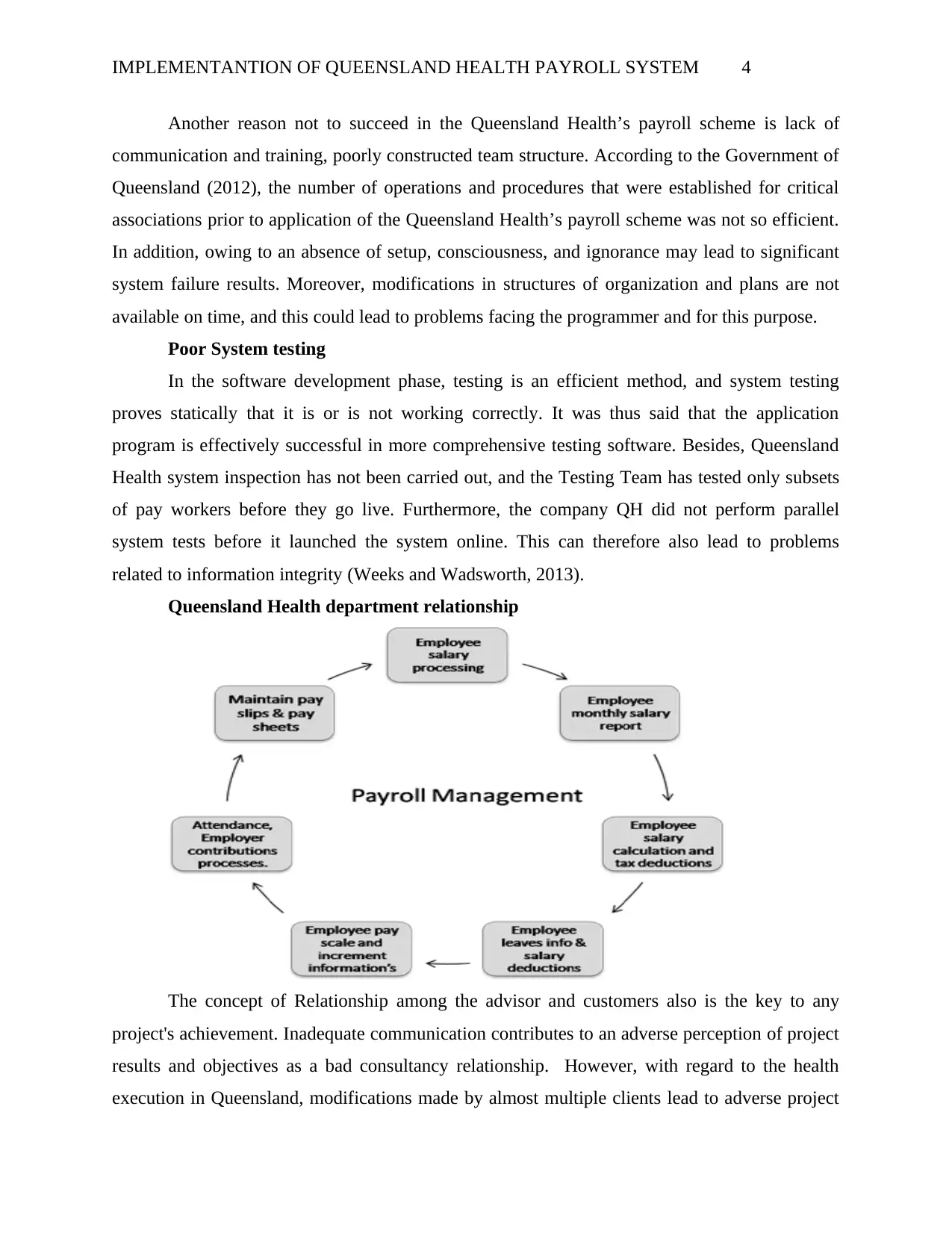
IMPLEMENTANTION OF QUEENSLAND HEALTH PAYROLL SYSTEM 4
Another reason not to succeed in the Queensland Health’s payroll scheme is lack of
communication and training, poorly constructed team structure. According to the Government of
Queensland (2012), the number of operations and procedures that were established for critical
associations prior to application of the Queensland Health’s payroll scheme was not so efficient.
In addition, owing to an absence of setup, consciousness, and ignorance may lead to significant
system failure results. Moreover, modifications in structures of organization and plans are not
available on time, and this could lead to problems facing the programmer and for this purpose.
Poor System testing
In the software development phase, testing is an efficient method, and system testing
proves statically that it is or is not working correctly. It was thus said that the application
program is effectively successful in more comprehensive testing software. Besides, Queensland
Health system inspection has not been carried out, and the Testing Team has tested only subsets
of pay workers before they go live. Furthermore, the company QH did not perform parallel
system tests before it launched the system online. This can therefore also lead to problems
related to information integrity (Weeks and Wadsworth, 2013).
Queensland Health department relationship
The concept of Relationship among the advisor and customers also is the key to any
project's achievement. Inadequate communication contributes to an adverse perception of project
results and objectives as a bad consultancy relationship. However, with regard to the health
execution in Queensland, modifications made by almost multiple clients lead to adverse project
Another reason not to succeed in the Queensland Health’s payroll scheme is lack of
communication and training, poorly constructed team structure. According to the Government of
Queensland (2012), the number of operations and procedures that were established for critical
associations prior to application of the Queensland Health’s payroll scheme was not so efficient.
In addition, owing to an absence of setup, consciousness, and ignorance may lead to significant
system failure results. Moreover, modifications in structures of organization and plans are not
available on time, and this could lead to problems facing the programmer and for this purpose.
Poor System testing
In the software development phase, testing is an efficient method, and system testing
proves statically that it is or is not working correctly. It was thus said that the application
program is effectively successful in more comprehensive testing software. Besides, Queensland
Health system inspection has not been carried out, and the Testing Team has tested only subsets
of pay workers before they go live. Furthermore, the company QH did not perform parallel
system tests before it launched the system online. This can therefore also lead to problems
related to information integrity (Weeks and Wadsworth, 2013).
Queensland Health department relationship
The concept of Relationship among the advisor and customers also is the key to any
project's achievement. Inadequate communication contributes to an adverse perception of project
results and objectives as a bad consultancy relationship. However, with regard to the health
execution in Queensland, modifications made by almost multiple clients lead to adverse project
Paraphrase This Document
Need a fresh take? Get an instant paraphrase of this document with our AI Paraphraser
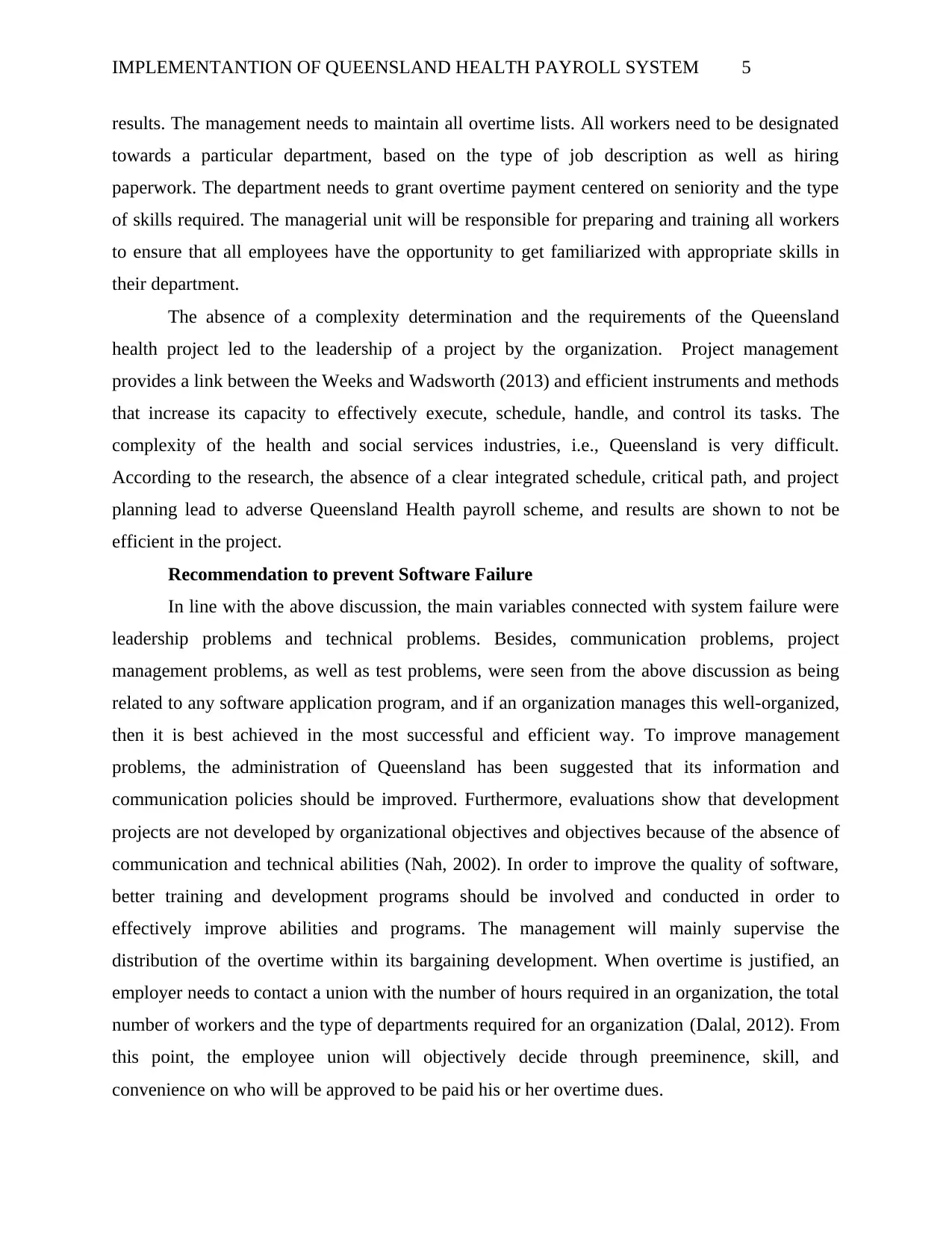
IMPLEMENTANTION OF QUEENSLAND HEALTH PAYROLL SYSTEM 5
results. The management needs to maintain all overtime lists. All workers need to be designated
towards a particular department, based on the type of job description as well as hiring
paperwork. The department needs to grant overtime payment centered on seniority and the type
of skills required. The managerial unit will be responsible for preparing and training all workers
to ensure that all employees have the opportunity to get familiarized with appropriate skills in
their department.
The absence of a complexity determination and the requirements of the Queensland
health project led to the leadership of a project by the organization. Project management
provides a link between the Weeks and Wadsworth (2013) and efficient instruments and methods
that increase its capacity to effectively execute, schedule, handle, and control its tasks. The
complexity of the health and social services industries, i.e., Queensland is very difficult.
According to the research, the absence of a clear integrated schedule, critical path, and project
planning lead to adverse Queensland Health payroll scheme, and results are shown to not be
efficient in the project.
Recommendation to prevent Software Failure
In line with the above discussion, the main variables connected with system failure were
leadership problems and technical problems. Besides, communication problems, project
management problems, as well as test problems, were seen from the above discussion as being
related to any software application program, and if an organization manages this well-organized,
then it is best achieved in the most successful and efficient way. To improve management
problems, the administration of Queensland has been suggested that its information and
communication policies should be improved. Furthermore, evaluations show that development
projects are not developed by organizational objectives and objectives because of the absence of
communication and technical abilities (Nah, 2002). In order to improve the quality of software,
better training and development programs should be involved and conducted in order to
effectively improve abilities and programs. The management will mainly supervise the
distribution of the overtime within its bargaining development. When overtime is justified, an
employer needs to contact a union with the number of hours required in an organization, the total
number of workers and the type of departments required for an organization (Dalal, 2012). From
this point, the employee union will objectively decide through preeminence, skill, and
convenience on who will be approved to be paid his or her overtime dues.
results. The management needs to maintain all overtime lists. All workers need to be designated
towards a particular department, based on the type of job description as well as hiring
paperwork. The department needs to grant overtime payment centered on seniority and the type
of skills required. The managerial unit will be responsible for preparing and training all workers
to ensure that all employees have the opportunity to get familiarized with appropriate skills in
their department.
The absence of a complexity determination and the requirements of the Queensland
health project led to the leadership of a project by the organization. Project management
provides a link between the Weeks and Wadsworth (2013) and efficient instruments and methods
that increase its capacity to effectively execute, schedule, handle, and control its tasks. The
complexity of the health and social services industries, i.e., Queensland is very difficult.
According to the research, the absence of a clear integrated schedule, critical path, and project
planning lead to adverse Queensland Health payroll scheme, and results are shown to not be
efficient in the project.
Recommendation to prevent Software Failure
In line with the above discussion, the main variables connected with system failure were
leadership problems and technical problems. Besides, communication problems, project
management problems, as well as test problems, were seen from the above discussion as being
related to any software application program, and if an organization manages this well-organized,
then it is best achieved in the most successful and efficient way. To improve management
problems, the administration of Queensland has been suggested that its information and
communication policies should be improved. Furthermore, evaluations show that development
projects are not developed by organizational objectives and objectives because of the absence of
communication and technical abilities (Nah, 2002). In order to improve the quality of software,
better training and development programs should be involved and conducted in order to
effectively improve abilities and programs. The management will mainly supervise the
distribution of the overtime within its bargaining development. When overtime is justified, an
employer needs to contact a union with the number of hours required in an organization, the total
number of workers and the type of departments required for an organization (Dalal, 2012). From
this point, the employee union will objectively decide through preeminence, skill, and
convenience on who will be approved to be paid his or her overtime dues.
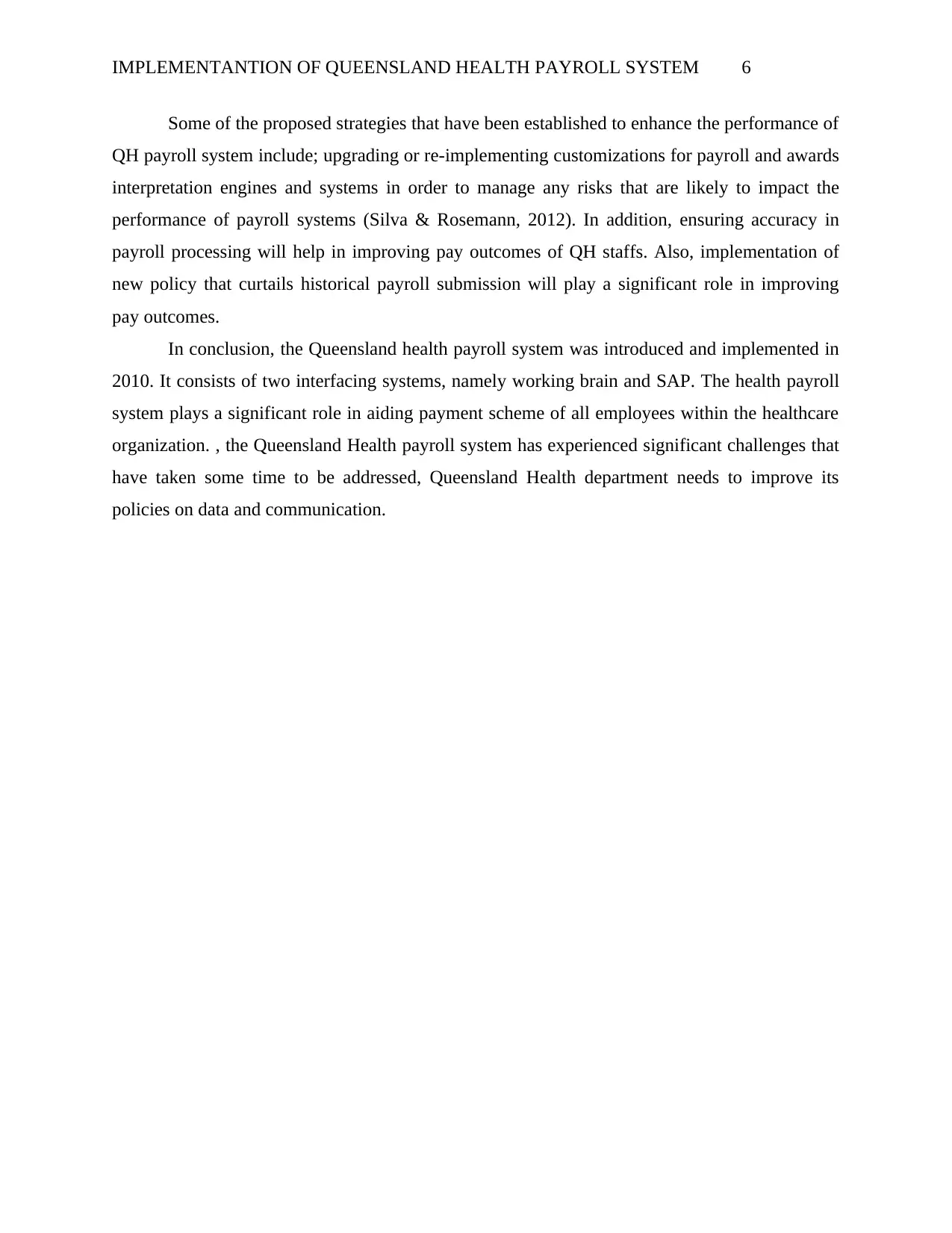
IMPLEMENTANTION OF QUEENSLAND HEALTH PAYROLL SYSTEM 6
Some of the proposed strategies that have been established to enhance the performance of
QH payroll system include; upgrading or re-implementing customizations for payroll and awards
interpretation engines and systems in order to manage any risks that are likely to impact the
performance of payroll systems (Silva & Rosemann, 2012). In addition, ensuring accuracy in
payroll processing will help in improving pay outcomes of QH staffs. Also, implementation of
new policy that curtails historical payroll submission will play a significant role in improving
pay outcomes.
In conclusion, the Queensland health payroll system was introduced and implemented in
2010. It consists of two interfacing systems, namely working brain and SAP. The health payroll
system plays a significant role in aiding payment scheme of all employees within the healthcare
organization. , the Queensland Health payroll system has experienced significant challenges that
have taken some time to be addressed, Queensland Health department needs to improve its
policies on data and communication.
Some of the proposed strategies that have been established to enhance the performance of
QH payroll system include; upgrading or re-implementing customizations for payroll and awards
interpretation engines and systems in order to manage any risks that are likely to impact the
performance of payroll systems (Silva & Rosemann, 2012). In addition, ensuring accuracy in
payroll processing will help in improving pay outcomes of QH staffs. Also, implementation of
new policy that curtails historical payroll submission will play a significant role in improving
pay outcomes.
In conclusion, the Queensland health payroll system was introduced and implemented in
2010. It consists of two interfacing systems, namely working brain and SAP. The health payroll
system plays a significant role in aiding payment scheme of all employees within the healthcare
organization. , the Queensland Health payroll system has experienced significant challenges that
have taken some time to be addressed, Queensland Health department needs to improve its
policies on data and communication.
⊘ This is a preview!⊘
Do you want full access?
Subscribe today to unlock all pages.

Trusted by 1+ million students worldwide
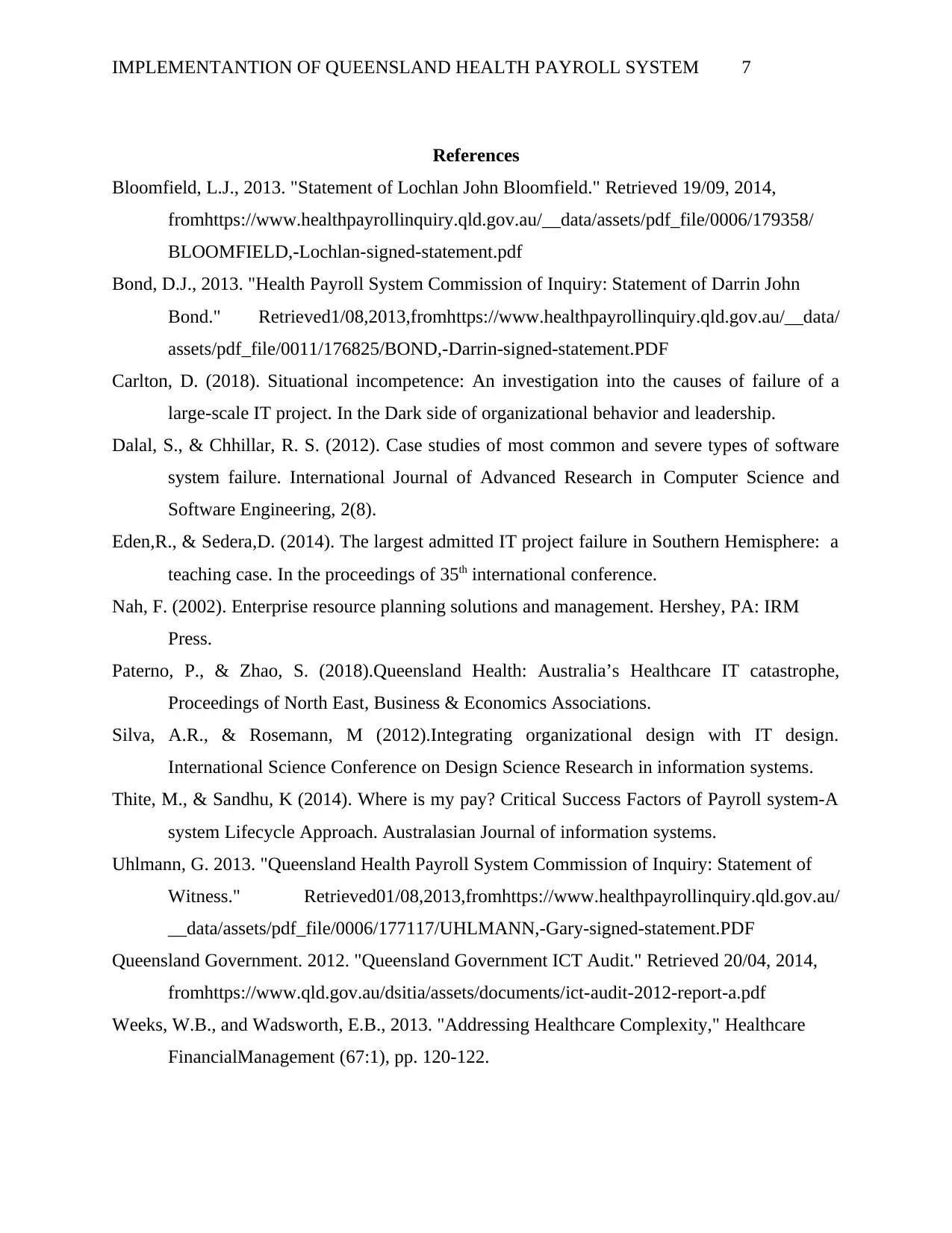
IMPLEMENTANTION OF QUEENSLAND HEALTH PAYROLL SYSTEM 7
References
Bloomfield, L.J., 2013. "Statement of Lochlan John Bloomfield." Retrieved 19/09, 2014,
fromhttps://www.healthpayrollinquiry.qld.gov.au/__data/assets/pdf_file/0006/179358/
BLOOMFIELD,-Lochlan-signed-statement.pdf
Bond, D.J., 2013. "Health Payroll System Commission of Inquiry: Statement of Darrin John
Bond." Retrieved1/08,2013,fromhttps://www.healthpayrollinquiry.qld.gov.au/__data/
assets/pdf_file/0011/176825/BOND,-Darrin-signed-statement.PDF
Carlton, D. (2018). Situational incompetence: An investigation into the causes of failure of a
large-scale IT project. In the Dark side of organizational behavior and leadership.
Dalal, S., & Chhillar, R. S. (2012). Case studies of most common and severe types of software
system failure. International Journal of Advanced Research in Computer Science and
Software Engineering, 2(8).
Eden,R., & Sedera,D. (2014). The largest admitted IT project failure in Southern Hemisphere: a
teaching case. In the proceedings of 35th international conference.
Nah, F. (2002). Enterprise resource planning solutions and management. Hershey, PA: IRM
Press.
Paterno, P., & Zhao, S. (2018).Queensland Health: Australia’s Healthcare IT catastrophe,
Proceedings of North East, Business & Economics Associations.
Silva, A.R., & Rosemann, M (2012).Integrating organizational design with IT design.
International Science Conference on Design Science Research in information systems.
Thite, M., & Sandhu, K (2014). Where is my pay? Critical Success Factors of Payroll system-A
system Lifecycle Approach. Australasian Journal of information systems.
Uhlmann, G. 2013. "Queensland Health Payroll System Commission of Inquiry: Statement of
Witness." Retrieved01/08,2013,fromhttps://www.healthpayrollinquiry.qld.gov.au/
__data/assets/pdf_file/0006/177117/UHLMANN,-Gary-signed-statement.PDF
Queensland Government. 2012. "Queensland Government ICT Audit." Retrieved 20/04, 2014,
fromhttps://www.qld.gov.au/dsitia/assets/documents/ict-audit-2012-report-a.pdf
Weeks, W.B., and Wadsworth, E.B., 2013. "Addressing Healthcare Complexity," Healthcare
FinancialManagement (67:1), pp. 120-122.
References
Bloomfield, L.J., 2013. "Statement of Lochlan John Bloomfield." Retrieved 19/09, 2014,
fromhttps://www.healthpayrollinquiry.qld.gov.au/__data/assets/pdf_file/0006/179358/
BLOOMFIELD,-Lochlan-signed-statement.pdf
Bond, D.J., 2013. "Health Payroll System Commission of Inquiry: Statement of Darrin John
Bond." Retrieved1/08,2013,fromhttps://www.healthpayrollinquiry.qld.gov.au/__data/
assets/pdf_file/0011/176825/BOND,-Darrin-signed-statement.PDF
Carlton, D. (2018). Situational incompetence: An investigation into the causes of failure of a
large-scale IT project. In the Dark side of organizational behavior and leadership.
Dalal, S., & Chhillar, R. S. (2012). Case studies of most common and severe types of software
system failure. International Journal of Advanced Research in Computer Science and
Software Engineering, 2(8).
Eden,R., & Sedera,D. (2014). The largest admitted IT project failure in Southern Hemisphere: a
teaching case. In the proceedings of 35th international conference.
Nah, F. (2002). Enterprise resource planning solutions and management. Hershey, PA: IRM
Press.
Paterno, P., & Zhao, S. (2018).Queensland Health: Australia’s Healthcare IT catastrophe,
Proceedings of North East, Business & Economics Associations.
Silva, A.R., & Rosemann, M (2012).Integrating organizational design with IT design.
International Science Conference on Design Science Research in information systems.
Thite, M., & Sandhu, K (2014). Where is my pay? Critical Success Factors of Payroll system-A
system Lifecycle Approach. Australasian Journal of information systems.
Uhlmann, G. 2013. "Queensland Health Payroll System Commission of Inquiry: Statement of
Witness." Retrieved01/08,2013,fromhttps://www.healthpayrollinquiry.qld.gov.au/
__data/assets/pdf_file/0006/177117/UHLMANN,-Gary-signed-statement.PDF
Queensland Government. 2012. "Queensland Government ICT Audit." Retrieved 20/04, 2014,
fromhttps://www.qld.gov.au/dsitia/assets/documents/ict-audit-2012-report-a.pdf
Weeks, W.B., and Wadsworth, E.B., 2013. "Addressing Healthcare Complexity," Healthcare
FinancialManagement (67:1), pp. 120-122.
Paraphrase This Document
Need a fresh take? Get an instant paraphrase of this document with our AI Paraphraser

IMPLEMENTANTION OF QUEENSLAND HEALTH PAYROLL SYSTEM 8
1 out of 8
Your All-in-One AI-Powered Toolkit for Academic Success.
+13062052269
info@desklib.com
Available 24*7 on WhatsApp / Email
![[object Object]](/_next/static/media/star-bottom.7253800d.svg)
Unlock your academic potential
Copyright © 2020–2025 A2Z Services. All Rights Reserved. Developed and managed by ZUCOL.

